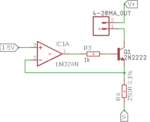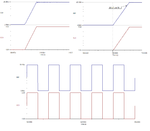jelezarov
Member level 1


I have this schematic for a 4-20mA current loop transmitter. My understanding is that the op-amp in my circuit compares its feedback from R4 with its input and adjusts its output so that the input voltage is equal to the voltage at R4. Then the Ohm's law takes care that exactly 4-20mA would flow when the input is 1-5V.
I need to transform the circuit in such way, so that the loop ("4-20MA_OUT" in my circuit) shares the ground (V-) instead of (V+), but can't think of a way for the described comparison to work because one does not know the resistance of the loop.







